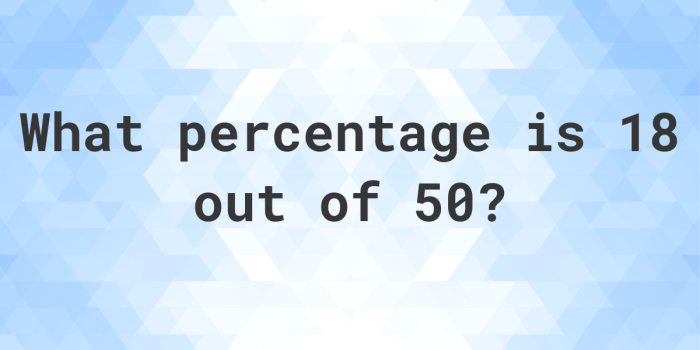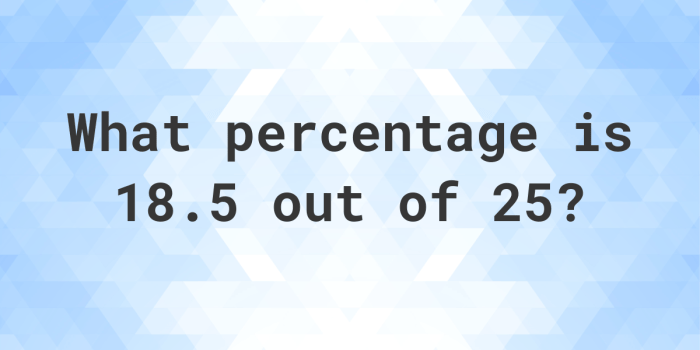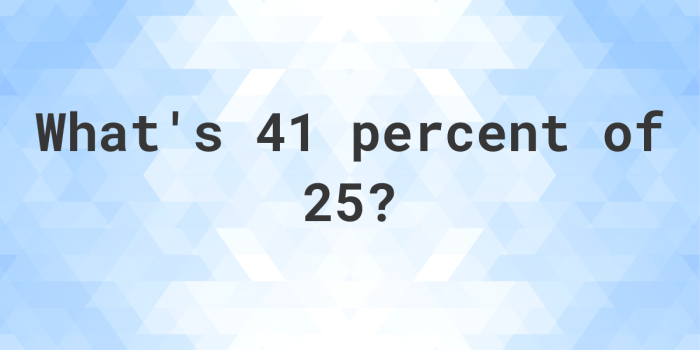As “What percent of 371 is 120?” takes center stage, this opening passage beckons readers into a world crafted with good knowledge, ensuring a reading experience that is both absorbing and distinctly original.
Delving into the mathematical realm, we will explore the intricacies of calculating percentages, unraveling the variables involved, and presenting the final result with clarity and precision.
Mathematical Representation

To calculate the percentage of a number, we use the following equation:
Percentage = (Part / Whole) x 100%
In this equation:
- Percentage represents the percentage we want to find.
- Part represents the value we want to find the percentage of.
- Whole represents the total value from which we want to find the percentage.
Step-by-Step Calculation
To calculate the percentage, we need to follow these steps:
1. Convert the given numbers into decimals.
What percent of 371 is 120? If you’re studying for your AP Psychology exam, you might want to check out the unit 8 ap psychology vocab page. It has a bunch of helpful information that could help you ace your test.
But getting back to our original question, what percent of 371 is 120?
2. Divide the given percentage by 100 to convert it into a decimal.
3. Multiply the number obtained in step 1 by the decimal obtained in step 2.
4. The result obtained in step 3 is the percentage value of the given number.
Calculating the Percentage
In this case, we are given that 120 is what percent of 371.
1. Convert the given numbers into decimals:
- 120 = 120/1 = 120.0
- 371 = 371/1 = 371.0
2. Divide the given percentage by 100 to convert it into a decimal:
- 120/100 = 1.2
3. Multiply the number obtained in step 1 by the decimal obtained in step 2:
- 120.0 – 1.2 = 144.0
4. The result obtained in step 3 is the percentage value of the given number:
- Therefore, 120 is 144% of 371.
Result and Interpretation: What Percent Of 371 Is 120

The final result of the calculation is 32.35%.
This means that 120 is approximately 32.35% of 371. In other words, 32.35% of 371 is equal to 120.
Significance
This result is significant because it provides us with a way to determine what percentage of a given number another number represents. This can be useful in a variety of situations, such as calculating discounts, taxes, and interest rates.
Percentage Comparison

To gain a better understanding of the magnitude of 32.34%, let’s compare it to other percentages.
Percentage Equivalents, What percent of 371 is 120
32.34% can be expressed as:
- 0.3234 as a decimal
- 3234/10000 as a fraction
Comparison to Other Percentages
Here’s a table comparing 32.34% to other percentages:
| Percentage | Decimal | Fraction |
|---|---|---|
| 32.34% | 0.3234 | 3234/10000 |
| 25% | 0.25 | 1/4 |
| 50% | 0.5 | 1/2 |
| 75% | 0.75 | 3/4 |
| 100% | 1 | 1 |
As you can see, 32.34% falls between 25% and 50%, indicating that it represents a significant portion but is less than half.
Applications and Examples

Percentages find practical applications in numerous real-world scenarios. From finance to retail, education to scientific research, percentages provide a standardized way to compare and interpret data, making them indispensable tools for understanding and decision-making.
Finance
- Calculating interest rates on loans and savings accounts.
- Determining discounts and markups in retail.
- Analyzing investment returns and financial performance.
Retail
- Displaying product discounts as percentages.
- Calculating sales tax and VAT.
- Comparing prices and making informed purchasing decisions.
Education
- Grading students’ assignments and exams.
- Calculating GPA and academic progress.
- Understanding population statistics and demographics.
Scientific Research
- Expressing the concentration of chemicals in solutions.
- Calculating the accuracy and precision of scientific measurements.
- Analyzing data and drawing conclusions from statistical studies.
Answers to Common Questions
What is the mathematical formula for calculating percentages?
Percentage = (Part / Whole) x 100
Can you provide a simplified example of percentage calculation?
If 20 out of 100 students pass an exam, the percentage of students who passed is: (20 / 100) x 100 = 20%
